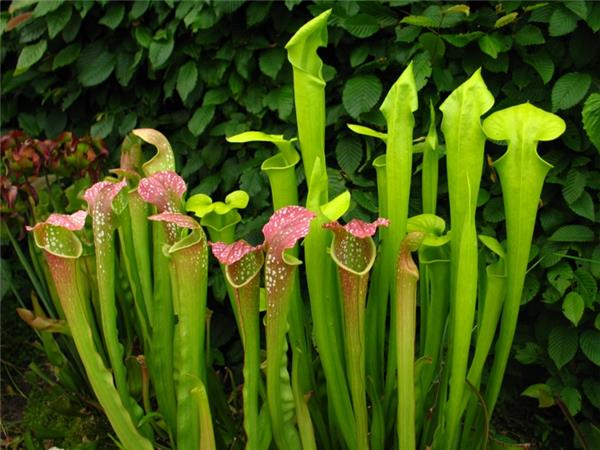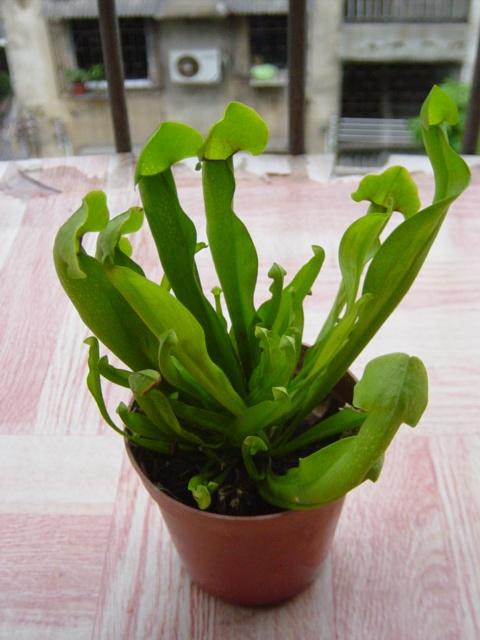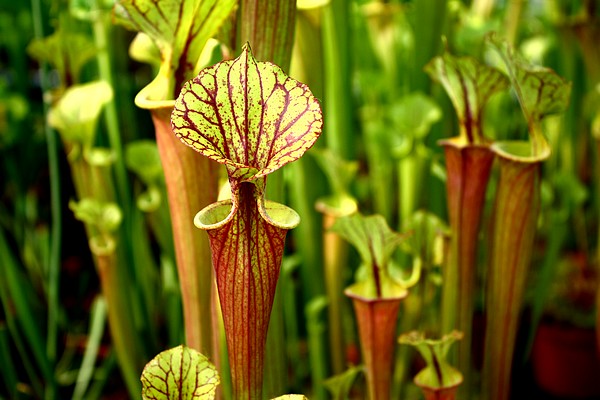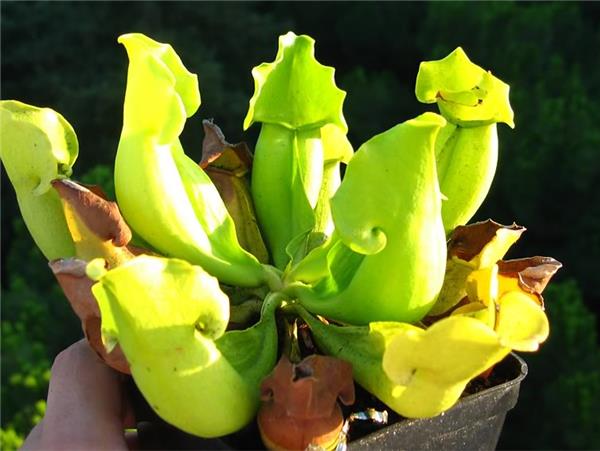The culture method of bottle grass how to raise cobra bottle grass
In modern times, many people like to raise carnivorous plants such as bottle grass and pitcher plants, and feel that the life of this small plant is very lovely. The editor will introduce to you the cultivation method of bottle grass. How to raise cobra bottle grass? I hope I can help you all.

Brief introduction of bottle grass
Bottle grass (scientific name: Sarraceniapurpurea), alias: purple bottle grass, purse pig cage, short bottle grass. Cryptomellidaceae, genus Coleoptera. Perennial evergreen herb with a height of 10 to 20 meters. No lotus. The leaves grow from the root and stem, the leaves are dimorphic, the spring leaves are cylindrical, hollow like a small bottle, the opening is covered with a beautiful purple pattern on the lid and the mouth of the bottle, and the appearance is green or red; the leaves growing in the middle of summer are sword-shaped. Flowers small, solitary, purple. Capsule. Like warm, humid and semi-overcast environment. It is cold-resistant, warm in winter, cool in summer, not resistant to dryness and high temperature, and afraid of strong light. The suitable temperature for growth in summer is 1925 ℃, and the temperature in winter is not lower than 4 ℃. From November to early March of the following year is a dormant period, it is appropriate to maintain a certain humidity, can not be dry. Like loose, barren acid soil.
The culture method of bottle grass
Temperature: like warm winter and cool summer, the suitable temperature for growth is 10-20V, more hardy. In winter, the plant is dormant, and the temperature should not be lower than-5 °C, but it is best to maintain a temperature above 8C. It is not tolerant to dry and high temperature in summer, and the suitable temperature for growth is 20 ~ 26 ℃. Shading, environmental water spraying and strengthening ventilation should be adopted to create a cooler environment.

Light: like the semi-overcast environment, strong sunlight will burn the leaf tube. From late spring to early autumn, you should pay attention to shade, cover 50% to 60% of the sunlight, or place where there is enough scattered light to avoid direct sunlight. At other times, plenty of light is needed. Plants that fully receive sunlight in the open field in winter and spring are often greener than bottle-shaped leaves cultivated in greenhouses or greenhouses.
Watering: like wet soil environment, not resistant to drought. The growing period should be well watered to keep the substrate moist. Control watering in winter and moist it a little. The water temperature should be prevented from getting too high in summer, otherwise it will cause rotten roots. Rain Water should be used for watering. Avoid watering water containing calcareous matter.
Environmental humidity: like the humid environment, not resistant to drying, the growing period should often spray water to the plant and its surroundings, in order to keep the environment moist. Spraying more foliar water in summer can not only reduce the ambient temperature, but also avoid the adverse effects of hot and dry wind on plants.
Fertilization: nitrogen-based fertilizer is applied once every semimonthly in spring, 0.2%-0.3% fertilizer can be used to irrigate the root, or diluted fertilizer can be directly poured into the pest bag for absorption. The species with red leaves and red veins should pay attention to the cooperation of nitrogen, phosphorus and potassium, so as to make the leaves bright and improve the ornamental value. Do not apply nitrogen fertilizer simply or too much, or the leaves will fade and fade. Fertilization should be light rather than thick, thick fertilizer is easy to cause fertilizer damage. When dormant in winter, fertilizer should be stopped.

Upper basin: like barren acidic soil. The matrix is made of peat soil, water moss, perlite and other materials, or it can be planted with peat soil alone. The bottom of the basin should be padded with broken bricks or pieces. Planting should not be too deep, so that half of the rhizome should be exposed to the soil. After planting, cover the basin with a small amount of moss to moisturize the basin, and then place the bowl in shallow water at a depth of 3 to 4 meters. Culture method of evergreen of flowers and leaves
Pest control: there are leaf spot disease, root rot and aphids, shell insects, red spiders and other diseases and insect pests.
How to raise cobra bottle grass
1. Matrix
Peat, sand, water moss, peat, perlite, coconut shell and so on.
two。 Watering
Need to use soft water irrigation, such as Rain Water, distilled water, reverse osmosis deionized water and so on. Tap water in some areas contains a lot of minerals (especially calcium salts). These calcium salts will be deposited, killing plants. This is because most insectivorous plants have adapted to poor and acidic soils, so they are extremely calcium-avoiding plants, so they are very sensitive to nutrients in the soil.

3. Temperature
Resistant to cold and heat, especially to keep the root cold, there should be a large temperature difference between day and night; it can survive between minus 10 degrees and 30 degrees, and 15 to 27 degrees is the most suitable temperature for its growth. Like strong light, in the temperature is not too high, can accept the sunlight, the top of the plant will show a red net pattern, very beautiful.
4. Diseases and insect pests
Vulnerable to aphids or pink scale. Smaller hazards should be removed by hand, while larger hazards should be treated with pesticides as appropriate. Isopropanol is an effective insecticide against scale insects. Diazinone is also a broad-spectrum insecticide that most insectivorous plants can tolerate. Malathion and acephate are also suitable for insectivorous plants.
Although pests are a problem, the biggest problem is Botrytis cinerea. It develops in a warm and humid environment and becomes a serious problem in winter. Put it in a cool, well-ventilated environment, and remove the diseased branches in time, which can inhibit the development of Botrytis cinerea to some extent. If it fails, fungicides should be used as appropriate.

The above content is the editor's introduction to the cultivation method of bottle grass, how to raise cobra bottle grass. After you read it, do you have a better understanding of bottle grass? you can also raise it yourself if you like.
Smaller hazards should be removed by hand, while larger hazards should be treated with pesticides as appropriate. Isopropanol is an effective insecticide against scale insects. Diazinone is also a broad-spectrum insecticide that most insectivorous plants can tolerate. Malathion and acephate are also suitable for insectivorous plants.
Although pests are a problem, the biggest problem is Botrytis cinerea. It develops in a warm and humid environment and becomes a serious problem in winter. Put it in a cool, well-ventilated environment, and remove the diseased branches in time, which can inhibit the development of Botrytis cinerea to some extent. If it fails, fungicides should be used as appropriate.

The above content is the editor's introduction to the cultivation method of bottle grass, how to raise cobra bottle grass. After you read it, do you have a better understanding of bottle grass? you can also raise it yourself if you like.
Related
- Wuhan Hospital Iron Tree Blooming Result Was Instantly Frightened by the Gardener Master
- Which variety of camellia is the most fragrant and best? Which one do you like best?
- What is the small blue coat, the breeding methods and matters needing attention of the succulent plant
- Dormancy time and maintenance management of succulent plants during dormancy
- Minas succulent how to raise, Minas succulent plant pictures
- What are the varieties of winter succulent plants
- How to raise succulent plants in twelve rolls? let's take a look at some experience of breeding twelve rolls.
- Attention should be paid to water control for succulent plants during dormant period (winter and summer)
- Watering experience of twelve rolls of succulent plants
- Techniques for fertilizing succulent plants. An article will let you know how to fertilize succulent plants.



